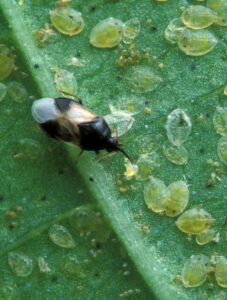Iowans spending time outdoors on warm fall days may experience a piercing bite from a nearly invisible foe.
Minute pirate bugs, whose scientific name, Orius insidiosus, gives rise to its other moniker, the insidious flower bug, can inflict painful bites relative to its size.
Entomologist Donald Lewis, of Iowa State University Extension and Outreach, notes that the surprisingly painful bites are inflicted by the bug’s short blunt beak into the skin.
Related: Nature watch: the praying mantis
Minute pirate bugs typically are noticed in late fall, before winter sets in, so with below-freezing temperatures in Iowa’s forecast this week, their days may be numbered.
Learn more in this article from the Horticulture and Home Pest News:
By Donald Lewis, Department of Entomology
The nicest, sunniest, warmest days of autumn are when most of us first notice the minute pirate bugs (also called the insidious flower bug). While we’re enjoying the sunshine the pirate bugs are casting about looking for just-one-more meal before winter sets in and shuts them down until next spring. The distinguishing characteristic of oval-shaped, black-and-white minute pirate bugs is that when they land on your bare skin they bite with a pain that is way out of proportion to their minute size (1/5th inch).
It’s easy to dislike something that bites, but in the big picture, minute pirate bugs are beneficial as predators feeding on insect eggs and small insects through the summer. They provide a valuable pest control service by helping to limit the number of pests in fields, gardens and woodlands.
The bite of minute pirate bugs is surprisingly painful. The bite is a probe with their short blunt beak into your skin. They do not feed on blood or inject a venom or saliva. People differ in their response to the bites. Bites on some swell up like a mosquito bite, some turn red and for others there is no reaction at all.
Urination? Of course not.
There is a preposterous urban legend that the pain of a minute pirate bug comes from urine that the bug excretes while biting. Where do these stories come from? Too much late night TV? There is absolutely no truth to the bizarre claims that minute pirate bugs pee on you or excrete acid to burn your skin.
Minute pirate bugs migrate from fields and woodland areas in late summer and early fall and vary from place-to-place, day-to-day and year-to-year. Migration and activity is random and not cyclic or predictable (though you can count on more activity on the warmest, sunniest days).
Control?
Minute pirate bugs are beneficial and come from a wide range of sources. Spray or fog treatments are not feasible. Available insect repellents have no effect on them.
Light colors seem to attract minute pirate bugs so long-sleeves and dark clothes while painting the house siding or gardening may help, as will working after dark and on cool, cloudy days.
Ultimately, minute pirate bug activity stops with the arrival of cold temperatures.


No Comments Yet